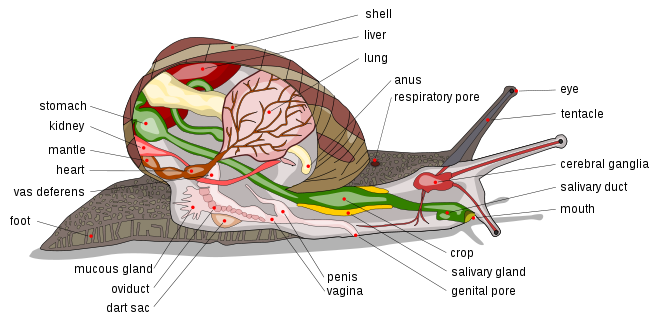Nutrition
Food and eating process - Terrestrial snails such as the Mountain Pillsnail eat a wide variety of vegetation such as leaves, stems, decaying vegetation, and fungi (Dourson, 2010). This makes the Mountain Pillsnail a vital piece in its habitat because it breaks down organic matter into smaller pieces so bacteria can further break it down into usable nutrients for plants. The snail begins eating by first examining the potential food with their chemorectptors which are located on the lower 2 tentacles (Dourson, 2010). The snail then touches the food with its foot and mouth and tears off bits of its' food with its' radula (Dourson, 2010). These feedings can last any where from a few minutes to an hour based on the durability of the food source (Dourson, 2010).
Digestion - The digestive system of the Mountain Pillsnail is made up of the radula, mouth, esophagus, stomach, and intestine (Bartsch, 1968). It is swallowed by the mouth and then moved down the esophagus by muscle contractions (Dourson, 2010). In the esophagus the food is mixed with saliva to help make it easier to slide through the digestive tract (Dourson, 2010). The food continues on its way to the stomach where it is further broken down and then is moved to the intestine by more muscle contractions (Purchon,1968). In the intestine three major types of cells take in nutrients: absorbtive cells, excretory cells, and flagellated cells (Purchon, 1968). After this it exits through the anus.
Soil Requirements - The Mountain Pillsnail, like all snails requires a certain kind of soil to live in. The snail thrives well in calcium rich soil (Dourson, 2010). This is because the snail takes in the calcium and is able to grow a bigger shell which in turn allows its body to become bigger (Dourson, 2010). The Mountain Pillsnail also requires a higher pH soil, more basic (Dourosn, 2010). It can survive in low pH soil but the diversity is limited (Dourson, 2010).
Circulatory System - The Mountain Pillsnail like most Mollusca has an open circulatory system (Gillis, 2012). This means the blood is not only limited to move through the heart and blood vessels, but actually flows over the whole body delivering oxygen to all of its organs (Gillis, 2012).
As a host - The Mountain Pillsnail, like most snails, plays host to Trematode worms (Dourson, 2010). When trematode eggs reach water they hatch into ciliated miracidium and search out for a snail in which they are chemically attracted to (Gillis, 2012). Once it penetrates the snail it develops into a sporocyst and reproduces asexually into more sporocysts or rediae (Gillis, 2012). These rediae develop tails as they grow into cercarie (Gillis, 2012). The cercarie then leave the snail to find their definitive host (Gillis, 2012).
Click here to proceed to our Interactions page.
This page created by Andrew Kragness.

